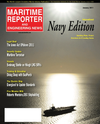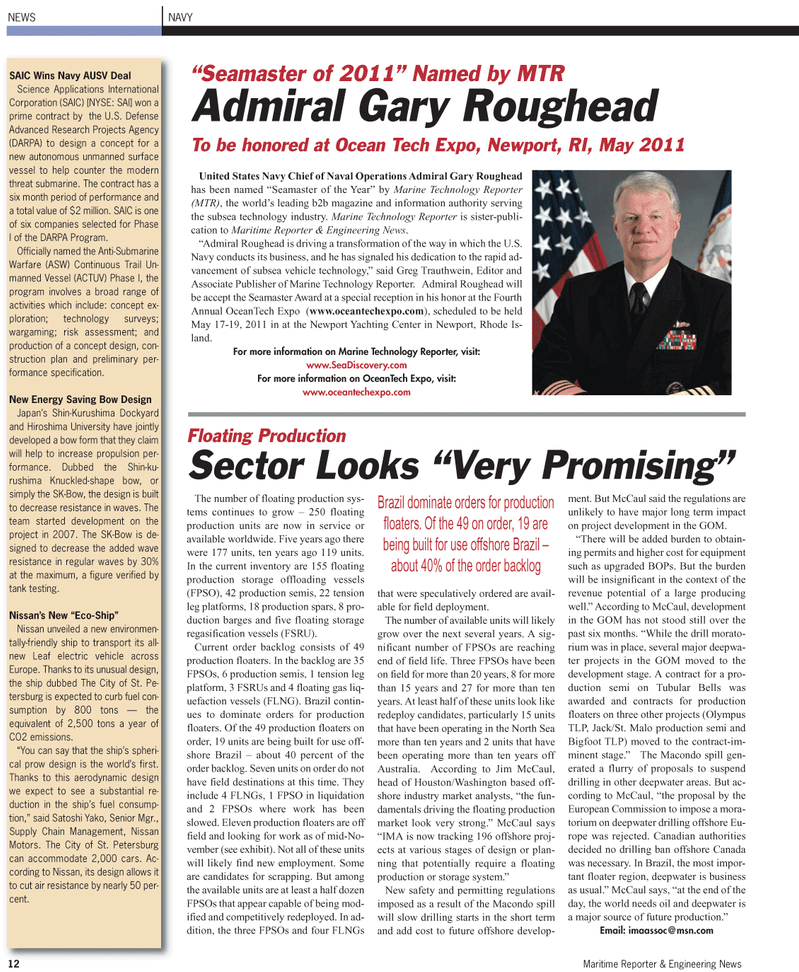
Page 12: of Maritime Reporter Magazine (January 2011)
International Naval Technology
Read this page in Pdf, Flash or Html5 edition of January 2011 Maritime Reporter Magazine
United States Navy Chief of Naval Operations Admiral Gary Roughead has been named “Seamaster of the Year” by Marine Technology Reporter (MTR), the world’s leading b2b magazine and information authority serving the subsea technology industry. Marine Technology Reporter is sister-publi- cation to Maritime Reporter & Engineering News. “Admiral Roughead is driving a transformation of the way in which the U.S.
Navy conducts its business, and he has signaled his dedication to the rapid ad- vancement of subsea vehicle technology,” said Greg Trauthwein, Editor and
Associate Publisher of Marine Technology Reporter. Admiral Roughead will be accept the Seamaster Award at a special reception in his honor at the Fourth
Annual OceanTech Expo (www.oceantechexpo.com), scheduled to be held
May 17-19, 2011 in at the Newport Yachting Center in Newport, Rhode Is- land.
For more information on Marine Technology Reporter, visit: www.SeaDiscovery.com
For more information on OceanTech Expo, visit: www.oceantechexpo.com
NEWS NAVY
SAIC Wins Navy AUSV Deal
Science Applications International
Corporation (SAIC) [NYSE: SAI] won a prime contract by the U.S. Defense
Advanced Research Projects Agency (DARPA) to design a concept for a new autonomous unmanned surface vessel to help counter the modern threat submarine. The contract has a six month period of performance and a total value of $2 million. SAIC is one of six companies selected for Phase
I of the DARPA Program.
Officially named the Anti-Submarine
Warfare (ASW) Continuous Trail Un- manned Vessel (ACTUV) Phase I, the program involves a broad range of activities which include: concept ex- ploration; technology surveys; wargaming; risk assessment; and production of a concept design, con- struction plan and preliminary per- formance specification.
New Energy Saving Bow Design
Japan’s Shin-Kurushima Dockyard and Hiroshima University have jointly developed a bow form that they claim will help to increase propulsion per- formance. Dubbed the Shin-ku- rushima Knuckled-shape bow, or simply the SK-Bow, the design is built to decrease resistance in waves. The team started development on the project in 2007. The SK-Bow is de- signed to decrease the added wave resistance in regular waves by 30% at the maximum, a figure verified by tank testing.
Nissan’s New “Eco-Ship”
Nissan unveiled a new environmen- tally-friendly ship to transport its all- new Leaf electric vehicle across
Europe. Thanks to its unusual design, the ship dubbed The City of St. Pe- tersburg is expected to curb fuel con- sumption by 800 tons — the equivalent of 2,500 tons a year of
CO2 emissions. “You can say that the ship’s spheri- cal prow design is the world’s first.
Thanks to this aerodynamic design we expect to see a substantial re- duction in the ship’s fuel consump- tion,” said Satoshi Yako, Senior Mgr.,
Supply Chain Management, Nissan
Motors. The City of St. Petersburg can accommodate 2,000 cars. Ac- cording to Nissan, its design allows it to cut air resistance by nearly 50 per- cent. 12 Maritime Reporter & Engineering News “Seamaster of 2011” Named by MTR
Admiral Gary Roughead
To be honored at Ocean Tech Expo, Newport, RI, May 2011
The number of floating production sys- tems continues to grow – 250 floating production units are now in service or available worldwide. Five years ago there were 177 units, ten years ago 119 units.
In the current inventory are 155 floating production storage offloading vessels (FPSO), 42 production semis, 22 tension leg platforms, 18 production spars, 8 pro- duction barges and five floating storage regasification vessels (FSRU).
Current order backlog consists of 49 production floaters. In the backlog are 35
FPSOs, 6 production semis, 1 tension leg platform, 3 FSRUs and 4 floating gas liq- uefaction vessels (FLNG). Brazil contin- ues to dominate orders for production floaters. Of the 49 production floaters on order, 19 units are being built for use off- shore Brazil – about 40 percent of the order backlog. Seven units on order do not have field destinations at this time. They include 4 FLNGs, 1 FPSO in liquidation and 2 FPSOs where work has been slowed. Eleven production floaters are off field and looking for work as of mid-No- vember (see exhibit). Not all of these units will likely find new employment. Some are candidates for scrapping. But among the available units are at least a half dozen
FPSOs that appear capable of being mod- ified and competitively redeployed. In ad- dition, the three FPSOs and four FLNGs that were speculatively ordered are avail- able for field deployment.
The number of available units will likely grow over the next several years. A sig- nificant number of FPSOs are reaching end of field life. Three FPSOs have been on field for more than 20 years, 8 for more than 15 years and 27 for more than ten years. At least half of these units look like redeploy candidates, particularly 15 units that have been operating in the North Sea more than ten years and 2 units that have been operating more than ten years off
Australia. According to Jim McCaul, head of Houston/Washington based off- shore industry market analysts, “the fun- damentals driving the floating production market look very strong.” McCaul says “IMA is now tracking 196 offshore proj- ects at various stages of design or plan- ning that potentially require a floating production or storage system.”
New safety and permitting regulations imposed as a result of the Macondo spill will slow drilling starts in the short term and add cost to future offshore develop- ment. But McCaul said the regulations are unlikely to have major long term impact on project development in the GOM. “There will be added burden to obtain- ing permits and higher cost for equipment such as upgraded BOPs. But the burden will be insignificant in the context of the revenue potential of a large producing well.” According to McCaul, development in the GOM has not stood still over the past six months. “While the drill morato- rium was in place, several major deepwa- ter projects in the GOM moved to the development stage. A contract for a pro- duction semi on Tubular Bells was awarded and contracts for production floaters on three other projects (Olympus
TLP, Jack/St. Malo production semi and
Bigfoot TLP) moved to the contract-im- minent stage.” The Macondo spill gen- erated a flurry of proposals to suspend drilling in other deepwater areas. But ac- cording to McCaul, “the proposal by the
European Commission to impose a mora- torium on deepwater drilling offshore Eu- rope was rejected. Canadian authorities decided no drilling ban offshore Canada was necessary. In Brazil, the most impor- tant floater region, deepwater is business as usual.” McCaul says, “at the end of the day, the world needs oil and deepwater is a major source of future production.”
Email: [email protected]
Floating Production
Sector Looks “Very Promising”
Brazil dominate orders for production floaters. Of the 49 on order, 19 are being built for use offshore Brazil – about 40% of the order backlog

 11
11

 13
13
